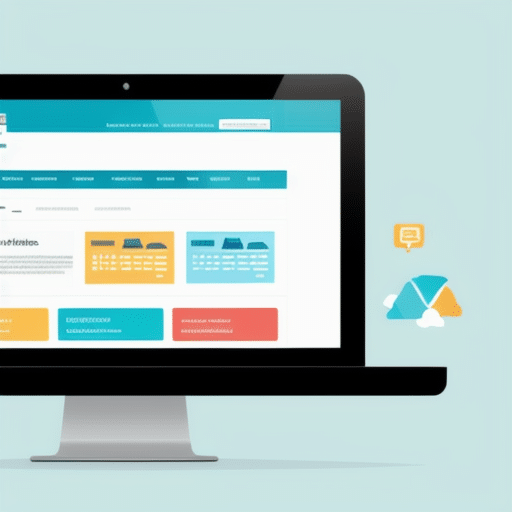Web architecture is a fundamental aspect of the web site design.
This discipline focuses on the organization and structuring of the contents, functionalities and navigation of a web page.
A good web architecture guarantees a satisfactory user experience, facilitates navigation and improves accessibility to information.
In this article, we will discuss the key concepts of web architecture, its different types and how to design an SEO-friendly architecture.
We will also analyze the most common errors in its implementation and provide tools and resources to create an efficient web architecture.
Finally, we will see how to evaluate and improve the web architecture of an existing site.
What is web architecture and why is it important?
Web architecture is the structure and organization of a website, from its design to its content and navigation.
This is important because a good web architecture improves user experienceThe site's content is easy to navigate and helps search engines understand the site's content, which can increase its visibility in search results.
Web architecture is also important for accessibility, as a clear and organized structure can make the site easier to use for people with visual or cognitive disabilities.
In addition, good web architecture can improve site loading speed and reduce bounce rate, which means visitors stay longer on the site and may be more likely to become customers or repeat users.
In short, web architecture is fundamental to the success of a web site. web siteThe company has a significant impact on key aspects such as user experience, accessibility, search engine rankings and conversion of visitors into customers.
Therefore, it is important to dedicate time and resources to designing a clear, coherent and efficient web architecture that meets the needs of both users and site objectives.
Types of web architecture: linear, hierarchical and mixed.
Web architecture refers to the structure and organization of a website.
There are different types of web architecture that can be used depending on the type of content you want to display and the way you want to present it.
One of the most common types is the linear architecture, which follows a linear sequence of pages with no branching or backtracking options.
This type of architecture is ideal for single-purpose websites, such as sales pages or registration forms.
Hierarchical architecture, on the other hand, organizes content into levels and categories, allowing the user to navigate back and forth between levels.
This type of architecture is suitable for websites with a large amount of content organized in different categories and subcategories.
Finally, mixed architecture combines elements of both previous types, allowing linear navigation in some cases and hierarchical navigation in others.
This type of architecture is useful for web sites with different sections or thematic areas that can have different navigation structures.
It is important to keep in mind that each type of architecture has its advantages and disadvantages, and choosing the right one will depend on the objective of the website and the type of content you want to display.
Web information architecture: how to organize content
Web information architecture is a crucial process for organizing content on a Web site.
The main objective is to provide a clear and coherent structure that allows users to easily navigate the site and find the information they are looking for quickly and efficiently.
To achieve this, it is important to start by defining the objectives of the site and the needs of the users.
Once these aspects have been established, you can proceed to the creation of a site map showing the overall structure of the site and how the different pages relate to each other.
It is important to keep in mind that web information architecture involves not only the organization of pages and content, but also the way menus and navigation links are presented.
There should be a clear and consistent hierarchy to ensure that users can easily find what they are looking for.
In addition, it is essential to properly label the content so that it is easily identifiable and understandable to users.
Clear and descriptive titles are essential to guide the user to the information they need.
In short, good web information architecture is crucial to the success of a website.
By organizing content effectively, you improve the user experience and increase the likelihood that visitors will return to the site in the future.
It is important to dedicate time and resources to this process to ensure that the site is well structured and organized from the outset.
How to design an SEO-friendly architecture
To design an SEO-friendly web architecture, it is important to consider several aspects.
First, keyword research should be conducted to identify the most relevant keywords for the website.
Then, these keywords should be used in the structure of the site, placing the most important pages at the top levels and creating coherent categories and subcategories.
Another important aspect is URL optimization, which must be clear and concise to facilitate search engine indexing.
In addition, you should avoid dynamic URLs and opt for static URLs with keywords.
It is also important to include a site map in XML format to facilitate site indexing.
This sitemap should be updated regularly to ensure that search engines are aware of any changes to the site structure.
Another way to optimize web architecture is through image optimization, using descriptive names and alternative text for each image.
The "nofollow" tag can also be used to prevent search engines from following certain links that are not relevant or important.
In summary, designing an SEO-friendly web architecture should consider keyword research, a clear and coherent structure, optimized URLs, a regularly updated sitemap, image optimization and the proper use of tags.
All of these elements can help improve your website's search engine ranking and increase your online visibility.
Common web architecture mistakes and how to avoid them
Although web architecture may seem like a simple task, there are many common mistakes that can harm user experience and search engine rankings.
One of the most frequent errors is the lack of coherence in the structure of the site, which makes navigation difficult and confuses the user.
To avoid this, it is important to establish a clear and consistent navigation scheme that allows the user to access any page of the site in a few clicks.
Another common mistake is the lack of attention to keywords and URL structure, which can negatively affect SEO.
To avoid this, it is recommended to conduct a thorough research of relevant keywords for each page and use them in URLs and meta tags.
Another erroneous practice is over-optimization, which consists of using too many keywords or repeating them excessively in the content, which can be considered as spam by search engines.
To avoid this, it is important to maintain a balance between optimization and content quality.
Finally, another common mistake is not paying attention to site loading speed, which can negatively affect both SEO and user experience.
To avoid this, it is recommended to optimize images and multimedia files, reduce file size and use tools to measure and improve loading speed.
Tools and resources for creating an efficient web architecture
To create a web architecture In order to be efficient, it is necessary to have the appropriate tools and resources to organize and structure the content in a clear and coherent manner.
One of the most popular tools for designing web architecture is the site map, which allows you to visualize the structure of the site and the relationship between the different sections and pages.
There are also diagramming tools, such as Lucidchart or Visio, that facilitate the creation of diagrams and navigation flows.
In addition, it is important to take into account the principles of web information architecture when organizing content.
For this purpose, tools such as card sorting, which consists of grouping content into categories and subcategories according to the user's logic, can be used.
Another useful tool is tree testing, which allows to evaluate the effectiveness of the site structure by performing navigation tests.
In terms of resources, there are design patterns that can serve as a reference for the organization of content.
For example, the F pattern, which suggests placing the most important elements at the top left of the page, or the Z pattern, which suggests guiding the user along a diagonal path through the page.
Finally, it is important to mention the importance of having an efficient CMS (Content Management System) platform, such as WordPress or Drupal, which allows you to manage the content and its structure in a simple and effective way.
In short, having the right tools and resources in place can make the difference between a confusing and disorganized web architecture and a clear and easily navigable structure for users.
How to evaluate and improve your site's web architecture
Evaluating and improving a site's web architecture is essential to ensure a good user experience and optimal search engine visibility.
To evaluate the web architecture, it is necessary to perform a thorough analysis of the site and its components, including the navigation structure, content organization, meta tags, and internal and external links.
It is important to identify any problems that may be affecting the usability or positioning of the site.
Once the problems have been identified, measures can be taken to improve the web architecture.
This may involve adjusting the navigation structure, reorganizing content to make it easier to find and access, optimizing meta tags and page titles, and making sure all internal and external links work properly.
It is also important to ensure that the site is optimized for mobile devices and has a fast loading time.
To improve web architecture, it is advisable to use tools such as Google Analytics to analyze user behavior on the site and obtain valuable information on how to improve navigation and design.
You can also use specific SEO tools, such as SEMrush or Ahrefs, to analyze the site structure and get suggestions on how to improve search engine rankings.
In conclusion, evaluating and improving a site's web architecture is an ongoing process that requires time and dedication, but can make a big difference in terms of usability and online positioning.
With the right tools and a well thought-out strategy, any site can improve its web architecture and offer a better experience to its users.
Web architecture is a fundamental issue for any online site.
It is important to understand what it is and how to design an efficient structure for the content.
In addition, there are different types of web architecture that can be applied depending on the needs of the site.
Web information architecture is another key aspect to consider in order to organize content effectively.
It is also important to design an SEO-friendly architecture to improve search engine rankings.
Although there are common mistakes in web architecture, they can be avoided with the right tools and resources.
Finally, evaluating and improving your site's web architecture is an ongoing task that can help you maintain a functional and efficient website.
Reflecting on all of the above, what is the main challenge you face in creating an efficient web architecture?




